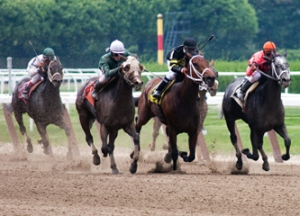Racehorse Fatalities Continue
NYSHA´s Spring/Summer 2008 newsletter featured an article on the Thoroughbred racing world and its stressful training regimens that create injuries for the immature equine athletes who compete. The article was written at the time of Barbaro´s euthanasia, despite months of post–operative nursing care after his Preakness breakdown, and also near the time of Eight Belles´ shattering both “ankles” after her stellar performance in the Kentucky Derby. Though their deaths were covered emotionally in depth, no mention was made of the other hundreds of unknown horses who died that year; they also broke down – fractured a limb or ruptured a ligament – – in races and were euthanized on the spot.

Statistically, 800 thoroughbred horses are said to have died in track injuries in 2001, and 1,247 in 2008. In December 2010, the Jockey Club tabulated “about 1510” track deaths in the previous 2 years from its Equine Injury Database. The high profile tragedies of Barbaro and Eight Belles fueled an intense public scrutiny on the racing industry, in which different causative factors for the unacceptably high breakdown and euthanasia rates were aired. Since America´s tracks are harder than European turf tracks, producing more stress injuries than their European counterparts on which horses run longer and sounder, racing commissions in the U.S. promoted the development of artificial tracks that were allegedly less concussive than present surfaces.Additionally, the Thoroughbred breeding industry debated the need to select horses for resilience and soundness, not just for blinding speed. Animal advocates criticized the early age at which the horses undergo training in order to be ready for the biggest stake races for two- and three-year olds. Since racing at two means that immature horses endure weight-bearing daily workouts long before their bones have matured, young horses are physically stressed by their arduous training on hard track surfaces to the point that they become injured and are never given adequate time to rest and fully heal.
Other risk factors included the use of certain racing shoes, anabolic steroids, diuretics, and stinging whips. In the spirit of reform that resulted from these deaths, various tracks initiated policies requiring the use of less-painful crops and specified what shoes were acceptable. Steroids were banned. New artificial track surfaces were installed in several locations — but have all these improvements resulted in an actual decrease in the fatality rate? In fact, race course fatalities dropped between 2007 and 2008, but only by 3%. And instead of concentrating on breeding for a sturdier physique, a grant from Science Foundation Ireland has funded the development of a test for a genetic marker indicating speed, and billionaire breeders are excited by the prospect of breeding an even faster, but possibly more fragile, horse.
It is doubtful that the racing industry will ever take the necessary steps to lessen its injury rates. Owners and spectators, eager for ever–faster records, will not choose horses capable of longer careers over the more exciting record–breakers. It is even more unlikely that the big stakes races will be postponed until the horses are fully matured at five to six years old – the expense of maintaining and training race horses for a longer period with a delayed return on the investment is unacceptable to owners and investors. Therefore, the message should be sent to the industry leaders by the public that the abuse their equine athletes suffer is unacceptable.
What you can do:
- NYSHA encourages you to seek out and support responsible local horse rescue organizations, whose operating costs are astronomical.
- Do not support the horse racing industry in any way.
- Write letters to the editor on this issue.
- Ask friends to boycott Thoroughbred racing.
- And, as always, if you see cruelty to or neglect of horses, please report it to the police or SPCA in your area, and follow up to make certain that the situation is resolved.
New York State Humane Association Humane Review, Vol.XXV, No.2, Fall 2011.